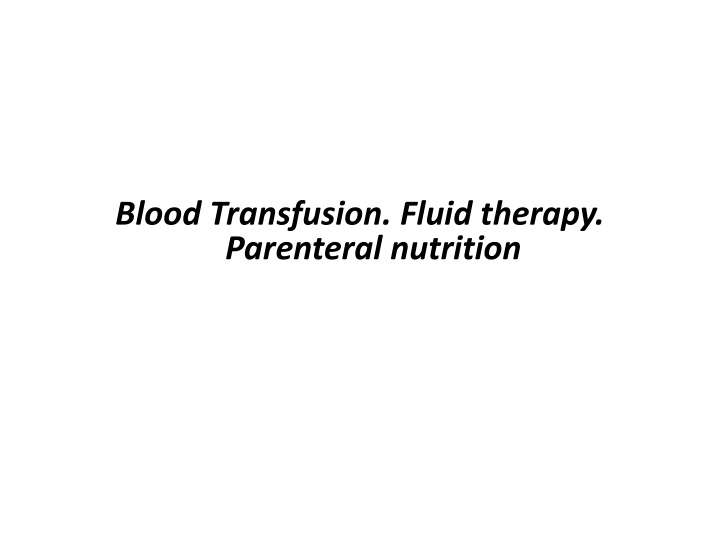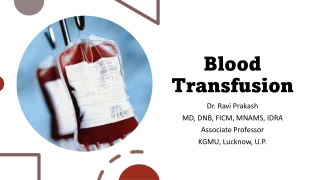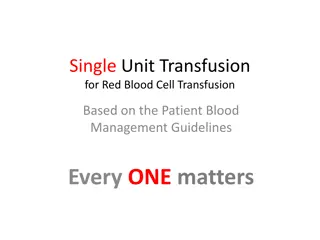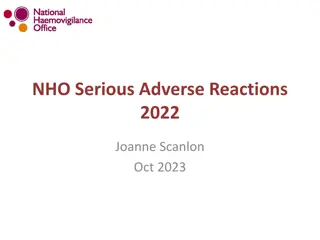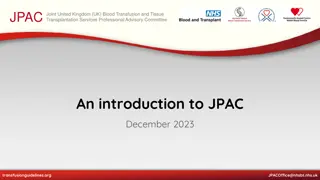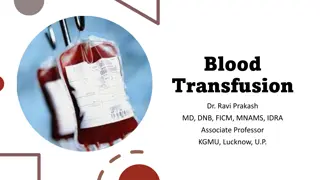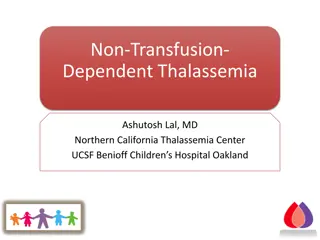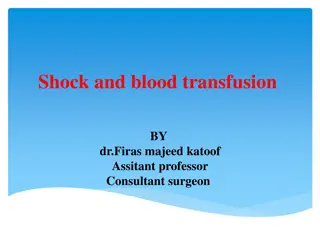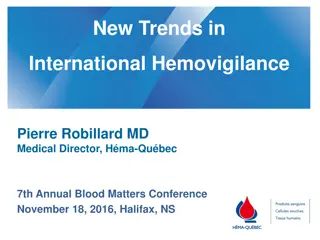Comprehensive Overview of Blood Transfusion and Therapy
This informative content delves into various aspects of blood transfusion, including red blood cell products, washed RBCs, clinical indications, leukocyte-depleted RBCs, leukocyte reduction, and cryopreserved RBCs. Learn about the processes involved, clinical indications, and benefits of each type of blood product.
Download Presentation

Please find below an Image/Link to download the presentation.
The content on the website is provided AS IS for your information and personal use only. It may not be sold, licensed, or shared on other websites without obtaining consent from the author.If you encounter any issues during the download, it is possible that the publisher has removed the file from their server.
You are allowed to download the files provided on this website for personal or commercial use, subject to the condition that they are used lawfully. All files are the property of their respective owners.
The content on the website is provided AS IS for your information and personal use only. It may not be sold, licensed, or shared on other websites without obtaining consent from the author.
E N D
Presentation Transcript
Blood Transfusion. Fluid therapy. Parenteral nutrition
Red blood cells Most RBC products are derived by collection of 450-500 ( 10%) mL of whole blood from volunteer donors and removal of the plasma by centrifugation. After removal of the plasma, the resulting product is red blood cells. Volume off 1 unit = 280 50 ml One unit of RBC will raise the hemoglobin of an average-size adult by ~1g/dL (or raise HCT ~3%)
Washed RBS RBC are washed with 0.9% sterile isotonic saline to remove the majority of plasma proteins, antibodies and electrolytes. The washed red cells are then resuspended in additive solution.
Clinical Indications for the Use of Wached RBS Waching of RBC: - Decreases risk of anaphylaxis in IgA-deficient patient with anti-IgA antibodies - Decreases reactions in patients with history of recurrent, severe allergic or anaphylactoid reactions to blood product transfusion
Leukocyte depleted RBC Most commonly achieved by filtration Usually soon after collection (prestorage) May be performed at bedside <5x106leukocytes per product
Leukocyte Reduction Decrease risk of recurrent febrile, nonhemolytic transfusion reactions Decrease risk of HLA-alloimmunization
Cryopreserved RBC Cryopreservation of RBC's is done to store special, rare RBC's for up to 10 years. The units are placed in special sterile containers in a deep freezer at less than -60 degrees C. Cryopreserved units are thawed and washed prior to use as saline suspended RBC's. These units must be used in 2 - 4 hours to prevent possible bacterial contamination.
Cryopreserved RBC Cryopreserved blood can help to maintain stores of Rh negative blood, to provide units for persons with antibodies to high-incidence antigens or persons difficult to cross-match because of multiple alloantibodies and to provide plasma-free blood to persons with IgA deficiency.
Red Blood Cell Transfusion Red blood cells should usually be administered when the hemoglobin concentration is low (e.g., less than 6 g/dl in a young, healthy patient), especially when the anemia is acute. Red blood cells are usually unnecessary when the hemoglobin concentration is more than 10 g/dl.
The hemoglobin concentrations (i.e., 6 10 g/dl) justify or require red blood cell transfusion should be based on any ongoing indication of organ ischemia, potential or actual ongoing bleeding (rate and magnitude), the patient s intravascular volume status, and the patient s risk factors for complications oxygenation. determination of whether intermediate of inadequate
Transfusion of fresh frozen plasma Coagulation tests (i.e., PT or INR and aPTT) should be obtained before the administration of FFP in a bleeding patient. Transfusion of FFP is not indicated if PT, INR, and aPTT are normal.
Clinical Indications for the Use of FFP 1. Correction of excessive microvascular bleeding (i.e., coagulopathy) in the presence of a PT greater than 1.5 times or an aPTT greater than 2 times normal; 2. correction of excessive microvascular bleeding secondary to coagulation factor deficiency in patients transfused with more than one blood volume (approximately 70 ml/kg) and when PT or INR and aPTT cannot be obtained in a timely fashion; 3. urgent reversal of warfarin therapy
Clinical Indications for the Use of FFP 4. correction of known coagulation factor deficiencies for which specific concentrates are unavailable; 5. heparin resistance (antithrombin III deficiency) in a patient requiring heparin Fresh frozen plasma should be given in doses calculated to achieve a minimum of 30% of plasma factor concentration (usually achieved with administration of 10 15 ml/kg FFP), except for urgent reversal of warfarin anticoagulation, for which 5 8 ml/kg FFP usually will suffice
Transfusion of platelets Volume 50 ml Dosage: 1U/ 10 kg Prophylactic administration (pt without microvascular bleeding):platelet count < 10.000/mmc. Pts with bleeding: In surgical or obstetric patients with normal platelet function, platelet transfusion is rarely indicated if the platelet count is known to be greater than 100 x 109/l and is usually indicated when the count is below 50 x 109/l in the presence of excessive bleeding.
Transfusion of platelets Vaginal deliveries or operative procedures ordinarily associated with limited blood loss may be performed in patients with platelet counts less than 50 _ 109/l. Platelet transfusion may be indicated despite an apparently adequate platelet count if there is known or suspected platelet dysfunction.
Albumin Human albumin is a normal constituent of plasma and acts like physiological albumin is predominantly derived from human plasma, human serum albumin are commercially available in a 5% solution, 20 % and a 25% solution.
Clinical Indications for the Use of Albumin to correct hypoproteinemia (serum protein < 50 g/l) Hypovolemic states burns treatment of oedema not responsive to diuretics (ascites, nephrotic syndrome).
Transfusion of cryoprecipitate VIII factor von Willebrand factor XIII factor fibrinogen fibronectin Volume 15 ml
Transfusion of cryoprecipitate If possible, a fibrinogen concentration should be obtained before the administration of cryoprecipitate in a bleeding patient. Transfusion of cryoprecipitate is rarely indicated if fibrinogen concentration is greater than 1,5 g/l. Transfusion of cryoprecipitate is usually indicated 1. when the fibrinogen concentration is less than 0,8 1,0 g/d in the presence of excessive microvascular bleeding 2. to correct excessive microvascular bleeding in massively transfused patients when fibrinogen concentrations cannot be measured in a timely fashion 3. for patients with congenital fibrinogen deficiencies.
Transfusion of cryoprecipitate The determination of whether patients with fibrinogen concentration between 1,0 and 1,5 g/l require therapy should be based on the potential for anticipated or ongoing bleeding and the risk of bleeding into a confined space (e.g., brain or eye).
Colloids Colloids are substances that do not dissolve into a true solution and do not pass through a semipermeable membrane.
Dextrans The formulations currently available are: Dextran 40 (Mw 40,000 [ Rheomacrodex ], sol.10% Dextran 70 (Mw 70,000 ) [ Macrodex ], sol.6% The dextrans cause more severe anaphylactic reactions than the gelatins or the starches. Dextran 70 has a duration of action of 6 to 8 hours. Interference with crossmatching can occurs . Dextran interferes with haemostasis. There is a maximal dosage recommendation of 1,5 g/kg/day).
Gelatin solutions Gelatin is the name given to the proteins formed when the connective tissues of animals are boiled. Gelofusine, Gelatinol The MW ranges from 5,000 to 50,000 with a weight-average MW of 35,000. Anaphylactoid reactions can occur No interference with blood cross-matching its use contributes to dilutional coagulopathy
Starches(HAES, Refortan, Voluven, Refortan- plus) These polydisperse colloid solutions are produced from amylopectin which has hydroxyethylation to prevent rapid hydrolysis by amylase. Hydroxyethylstarch is removed from the circulation by renal excretion. Anaphylactoid reactions occur in about 0.09% of cases. concern is the possibility that starch preparations can affect the coagulation process. Molecular weight 100.000-200.000 - 6% (Refortan), 10% (Refortan plus), Voluven (130.000, sol.6%). been stabilised by
Crystalloids Crystalloids pass freely through a semiper- meable membrane.
Crystalloids The most commonly used crystalloid fluid is normal saline, a solution of sodium chloride at 0.9% concentration 154 mmol Na and 154 mmol Cl/l infusion of 1 L of 0.9% sodium chloride (isotonic saline) adds 275 mL to the plasma volume and 825 mL to the interstitial volume.
Crystalloids Indice Plasma Sol. Sol.Ringer Sol.Ringer- 0.9% - lactat NaCl 154 154 Na Cl K 141 103 4-5 5/2 7.4 289 147-154 156 4 2,3/0 5-7 308 125-147 106-117 4-5,4 0,9-2,0/0 6.7 262-293 - - Ca/Mg Osmolarity 5.7 308 mosm/kg
Parenteral nutrition is usually indicated in the following situations Documented inability to absorb adequate nutrients via the GI tract such as: Massive small-bowel resection/short bowel syndrome (at least initially) Radiation enteritis Severe diarrhea Untreatable steatorrhea/malabsorption (i.e., not pancreatic insufficiency, small bowel bacterial overgrowth, or celiac disease) Complete bowel obstruction, or intestinal pseudo- obstruction
Severe catabolism with or without malnutrition when GI tract is not usable within 5 7 days Inability to obtain enteral access Inability to provide sufficient nutrients/fluids enterally Pancreatitis accompanied by abdominal pain Persistent GI hemorrhage Acute abdomen/ileus High output enterocutaneous fistula (>500 mL) and inability to gain enteral access distal to the fistula site Trauma requiring repeat surgical procedures
Parenteral nutrition may be indicated in the following situations Inflammatory bowel disease not responding to medical therapy Partial small bowel obstruction Intensive chemotherapy Major surgery/stress when enteral nutrition not expected to resume within 7 10 days Intractable vomiting when jejunal feeding is not possible
Amino acid solutions Protein is provided as a crystalline amino acid solution. 500 ml bottles are standard. Solutions vary in amino acid concentration and amino acid composition. (Aminosteril, Infezol,Aminoplasmal). Min 0,54 g/kg/day, optimal 0,8 g/kg/day - g/kgc/day. Should provide 15-30% of total caloric intake. Intrafuzin, de 1,2-1,6
Dextrose solutions Dextrose in solution has 3.4 kcalories per gram. Dextrose solutions come in different concentrations 3-4 g/kg/day provides 50-60% of total caloric intake.
Lipids Lipids in parenteral nutrition are used as a source of essential fatty acids and energy. Lipid emulsions are composed of soybean and/or safflower oil, glycerol, and egg phospholipid. IV lipids come in bottles of 10% or 20% emulsions. emulsion contains 1.1 kcal/ml the 20% emulsion contains 2 kcal/ml. (Lipofundin, Intralipid, Lipovenoz) (25-30% of total caloric intake). The 10%
FLUIDS 30-40 ml/kg/day
ELECTROLYTES & MICRONUTRIENTS Minerals and Electrolytes Na 60-100 mmol K 60-100 mmol Ca 5- 8 mmol P 20-45 mmol
Vitamins Commercial vitamin preparations for TPN are available. The vitamin requirements for TPN patients are different from non-TPN patients because absorption is not a factor with TPN. When needs are increased for certain disease states, single vitamin supplements can be added to the solution. Serum vitamin levels can be monitored and dosage adjusted accordingly. SOLUVIT, VITALIPID
Trace Elements Chromium 10-15 mcg Copper 0,3-0,5 mg Manganese 60-100 mcg Zinc 2,5-5 mg Selenium 20-60 mcg ADAMEL
